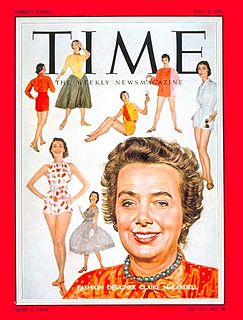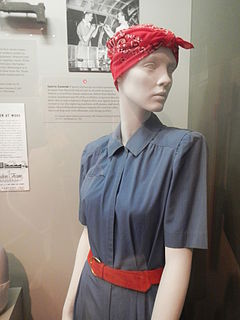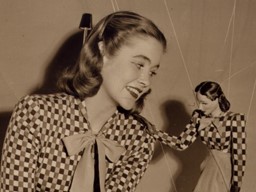Sydney Wragge (1908–1978) was an American fashion designer active during the 1940s, 1950s and 1960s. Working as B.H. Wragge, he was particularly renowned for his American sportswear, with the historian Caroline Rennolds Milbank declaring him the leader in mix-and-match separates and interchangeable wardrobe design. [1] In the 1930s and 1940s, Wragge, along with John Weitz, was one of the few male "pioneers" in the female-dominated world of early American sportswear design. [2] The fashion journalist Sally Kirkland, looking over the development of American sportswear, compared Wragge's design ethos to that of a later designer, Ralph Lauren, declaring that they shared impeccable taste and an eye for the best possible fabrics and prints. [3] He was known for his versatile work, offering jackets that worked with both full and narrow skirts, and two-piece dresses that worked equally well as interchangeable blouses and skirts. In the 1960s, he updated his work to successfully meet the demands of the next generation for even more practical, pared-down clothing. [1] When curating his major exhibition of American sportswear for the Metropolitan Museum of Art in 1998, Richard Martin noted that many of Wragge's former customers still retained the capsule wardrobes they had originally bought in the 1940s and 1950s. [1]

Sportswear is an American fashion term originally used to describe separates, but which, since the 1930s, has come to be applied to day and evening fashions of varying degrees of formality that demonstrate a specific relaxed approach to their design, while remaining appropriate for a wide range of social occasions. The term is not necessarily synonymous with activewear, clothing designed specifically for participants in sporting pursuits. Although sports clothing was available from European haute couture houses and "sporty" garments were increasingly worn as everyday or informal wear, the early American sportswear designers were associated with ready-to-wear manufacturers. While most fashions in America in the early 20th century were directly copied from, or influenced heavily by Paris, American sportswear became a home-grown exception to this rule, and could be described as the American Look. Sportswear was designed to be easy to look after, with accessible fastenings that enabled a modern emancipated woman to dress herself without a maid's assistance.
Hans Werner "John" Weitz was an American menswear designer who initiated licensing products and selling affordable but stylish clothing that featured his image in the advertising. He had a second career as a writer and historian. Weitz was also well known for being the husband of actress Susan Kohner and father of directors Paul Weitz and Chris Weitz.
Sally Kirkland was a manager at Lord & Taylor, a fashion editor at Vogue magazine and served as the only fashion editor at Life magazine between 1947 and 1969.
Wragge won his first Coty Award in 1952, a special award for "concept of dressing," and was awarded a second one in 1957. [4] He also received the Neiman Marcus Fashion Award in 1961. [4]
The Coty American Fashion Critics' Awards were created in 1942 by the cosmetics and perfume company Coty, Inc. to promote and celebrate American fashion, and encourage design during the Second World War. In 1985, the Coty Awards were discontinued; the CFDA Awards fulfill a similar role.
The Neiman Marcus Award for Distinguished Service in the Field of Fashion was a yearly award created in 1938 by Carrie Marcus Neiman and Stanley Marcus. Unlike the Coty Award, it was not limited to American-based fashion designers. Recipients of the Neiman Marcus Awards include couturiers, non-American-based designers, journalists, manufacturers, and celebrities and style icons who had had a significant personal influence upon fashion such as Grace Kelly and Grace Mirabella. The award was typically presented to multiple recipients each year, rather than to a single individual, although Adrian was the sole winner in 1943, a feat repeated in 1957 by Coco Chanel. From 1969 the awards became increasingly intermittent, with ceremonies held in 1973, 1979, 1980, 1984 and 1995, the last year in which the awards were presented. For the final ceremony, the founder, Stanley Marcus, received one of his own awards.
He was the first president of the Council of Fashion Designers of America, a trade association of prominent American fashion and accessory designers that was founded in 1962 by Eleanor Lambert, and held the post until 1965. [5]
The Council of Fashion Designers of America, Inc.(CFDA), founded in 1962 by publicist Eleanor Lambert, is a not-for-profit trade association of over 450 American fashion and accessory designers. The first president of the Council was Sydney Wragge. As of 2009, Diane von Fürstenberg was the group's president and Steven Kolb the CEO. The organization's stated mission is to strengthen the influence and success of American designers in the global economy.
Eleanor Lambert Berkson was an American fashion publicist. She was instrumental in increasing the international prominence of the American fashion industry and in the emergence of New York City as a major fashion capital. Lambert was the founder of New York Fashion Week, the Council of Fashion Designers of America, the Met Gala, and the International Best Dressed List.






